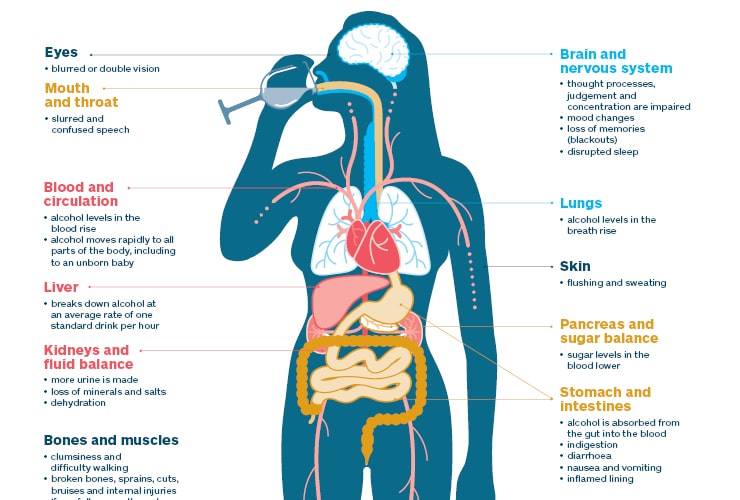Need a New Year’s Resolution? Try Dry January!
By: Jenna Ackerman, FNP
Why Dry January?
The start of a new year is an exciting time, usually inspiring a fresh start! Often, we find ourselves in a cycle of unhealthy habits, from grabbing that extra piece of pie, to having just one more beer, to putting off that exercise routine just a few more days. Sometimes just a temporary break from our daily habits can leave us feeling empowered to do more and take control of our lives in a purposeful way. Dry January is a time to slow down and take more time to focus on our health by holding back from alcohol for the month. More and more people are discovering the benefits of having a “reset” on consumption levels each January. As many as 20% of people are estimated to have participated in Dry January in 2019 (Ballard, 2019).
So, what are the benefits?
Health — Most of us know drinking too much can be dangerous to your health, but how much is too much? According to the CDC, one drink is defined as 12-ounces of beer (5% alcohol content), 8-ounces of malt liquor (7% alcohol content) or 5-ounces of wine (12% alcohol content). The CDC defines moderate drinking as up to one drink per day for women and up to two drinks per day for men; any amount over this has the potential to cause health concerns. High levels of alcohol have been known to contribute to heart disease, fatty liver, memory changes, high cholesterol, stroke and cancers of the breast, mouth, throat, esophagus, liver and colon (MacKey, 2025).

One Drink Measurements (The CDC)
The Impact of Alcohol
Alcohol has a range of effects on the brain and body. Many of these effects are determined by different risk factors such as health history, tolerance to alcohol and tolerance to drugs mixed with alcohol. Some immediate effects of alcohol on the brain include slurred speech, impulsive behavior, impaired vision, temporary memory loss and decreased control of coordination. Excessive or long-term use of alcohol can permanently interfere with how the brain functions. One effect of long-term alcohol use is neurotoxicity, which is the overuse of neurons causing them to “burn out”. This, in turn, makes reactions visibly slower. Another effect of alcohol directly impacts the structure of the brain. When exposed to alcohol for a long period of time, the brain matter can shrink (Butler Center for Research, 2015). More visible damages of long-term alcohol use include attention span, problem solving and memory, among others.

Alcohol’s Impact on the Body (Alcohol.org.nz)
As for the body, the heart is easily affected by alcohol use. Excessive use of alcohol can weaken the heart’s ability to move oxygen and nutrients throughout the body. Drinking can also increase the amount of fat in your blood, which can lead to heart disease and diabetes. The stomach is also easily at risk to the effects of excessive alcohol use. Over time, any pre-existing ulcers in the stomach can be worsened. If alcohol consumption is constant, the risk of developing an ulcer increases. The liver is another part of the body that can also be damaged. The liver breaks down the alcohol and removes it from the blood. Drinking too much in a short amount of time changes this process of removing alcohol, leading to fat build up on the liver. When a lot of fat builds up on the liver, it can cause medical conditions like kidney failure and type 2 diabetes. Other alcohol-related conditions that affect the liver are hepatitis, fibrosis and cirrhosis. Long-term use of alcohol can also negatively impact the pancreas. The blood vessels around the pancreas will swell, which causes pancreatitis. This illness often increases the chance of developing more serious ones, like pancreatic cancer. This type of cancer spreads quickly and can go unnoticed. Signs of pancreatic distress include abdominal pain, diarrhea, nausea, fast heart rate and fever (Galbicsek, 2019). If you experience any type of illness or distress due to alcohol consumption, contact a provider to receive medical help. To talk to a provider about your alcohol habits, call AxessPointe today at 888-975-9188. For more information on AxessPointe visit axesspointe.org
So, does taking a one-month break from alcohol really make a difference?
According to some recent research, the answer is yes! Studies from the National Institute of Health have shown that moderate drinkers who hold back for the month of January enjoy improvements in concentration and sleep patterns; reduced cholesterol, glucose levels and blood pressure; weight loss and as much as 40% loss of liver fat (Ballard, 2016). All are great benefits but seriously, who doesn’t want to sleep better?
Another benefit of participating in Dry January is money. The cost of alcohol can really add up! If you have two drinks at a bar at $6 each and one bottle of wine or a six-pack of beer over the course of a week, that is an easy $20 or more – just for the week. Add that up for the year and you’ve spent over $1,000 on alcohol alone. When you decide to cut out drinks for January the next decision is how to spend the extra $1,000 in your pocket. Research by the University of Sussex in England found 88 percent of those who participated in Dry January reported saving money as a result (Taylor, 2019).
Once you have decided you want to try it you may be thinking, “What am I going to do in January – just stay at home?” Consider this found time; you may want to take the opportunity to start a new exercise routine, learn a new hobby or take a class. More and more bars accommodate non-drinkers with a variety of non-alcoholic beverages or “mocktails.” Maybe head out with your friends for an evening but get a mocktail or sparkling water. It can be interesting to be the sober one for the night. Ultimately, if you decide to give Dry January a try, enjoy it. The extra time and money will allow you to do something good for your health and happiness, so treat yourself!
RESOURCES
Ballard, J. (2019, January 11). One in five Americans is participating in Dry January. Retrieved December 28, 2019, from https://today.yougov.com/topics/health/articles-reports/2019/01/11/dry-january-2019.
Ballard, J. (2016, January). What is Dry January? Retrieved December 28, 2019, from https://www.ncbi.nlm.nih.gov/pmc/articles/PMC4684010/.
Rehab 4 Addiction. (n.d.). How Alcohol Impacts Your Health. Retrieved February 6, 2025, from https://www.rehab4addiction.co.uk/guides/how-alcohol-impacts-health
Taylor, C. (2019, January 14). Your Money: How Dry January is changing finances. Retrieved December 28, 2019, from https://www.reuters.com/article/us-money-savings-dryjanuary/your-money-how-dry-january-is-changing-finances-idUSKCN1P80ZI.
Galbicsek, C. (2019, July 24). Effects of Alcohol on the Body and the Brain. Retrieved December 28, 2019, from https://www.alcoholrehabguide.org/alcohol/effects/.
Butler Center for Research. (2015, May 1). Alcohol Effects on the Brain. Retrieved December 28, 2019, from https://www.hazeldenbettyford.org/education/bcr/addiction-research/alcohol-effects-brain-ru-515.
Alcohol.org.nz. (n.d.). Effects on the Body. Retrieved December 28, 2019. From https://www.alcohol.org.nz/alcohol-its-effects/body-effects/effects-on-the-body


